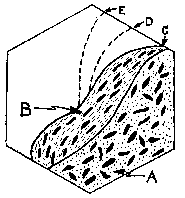The Theory of Tumbling
An understanding
of the theory behind a Process is always an aid to its practical application.
This article will tell you "how" and "why" a tumbler works.
Because we
have added so many thousands of new readers since it first appeared in
G & M, April '53, we reprint it here in the interests of complete coverage
of the tumbling process.
Because of the interest in lapidary
tumbling, some notes on the mechanics of the process may be of help to
the lapidary. The method has been used in industry for many years in cleaning,
deburring, and polishing metal, plastic, ceramic, and other materials.
The following information has been gleaned, for the most part, from trade
journals, catalogs, and technical literature. Some of it is from the author's
personal experience.
The speed of rotation of the
drum is "all important" in the rapid working of the material in the drum.
Surprising enough, there is just one speed at which the drum and its charge
will work most efficiently. Faster or slower than this speed will increase
the time necessary to finish the charge. The reason for this is easy to
understand when we know the processes at work in either grinding or polishing
in a tumbling drum. The mechanism is not one of tumbling, in spite of the
name. All, or at least 90%, of the work is done by a sliding motion of
the contents of the drum.
How Speed Effects Tumbling
The rotary speed of the drum for
maximum effect is that which causes a maximum of sliding effect. Let us
assume that we are using a hexagonal drum. The diagram shows the effect
of different speeds of rotation.
|
|
LEGEND
A - Nearly stationary material.
B - Sliding layer where grinding and polishing
takes place.
C - Point of start of sliding at 15 r.p.m.
D - Start of sliding at 25 r.p.m.
E - Start of sliding at 35 r.p.m. |
The material at "A" is doing
little or nothing except climb the side of the barrel. At point "C" it
begins to slide on its return to the bottom of the barrel and 90% of the
grinding and polishing takes place in this area, "B." As the speed is increased
from 15 r.p.m. to 25 r.p.m., the start of the slide point moves to "D"
but the total amount of the material contained in the sliding mass is less.
If one has an open-end drum and can watch the work as it moves in the barrel,
these effects are readily apparent.
As the speed is further increased
to 35 r.p.m., the sliding mass almost disappears and the material rolls
or tumbles to the bottom of the barrel. When this happens grinding and
polishing ceases for all practical purposes. All of these effects are easily
proven experimentally and anyone with a tumbling barrel can verify them
for himself.
Establish the Best Speed
The speeds given are for illustration
only and will vary with each individual case. Experiment with your drum
until you find the right speed to give the maximum thickness of the sliding
layers and consequently the maximum cutting effect. One manufacturer states
that with a 30" diameter barrel operating at 20 r.p.m., the sliding layer
is three inches thick.
I think that from the above
and by reference to the drawing, it is plain to see that the maximum cutting
rate will be obtained with a drum that is approximately half full. More
or less material, or "charge," will decrease, not only the number of pieces
finished, but also will cut down on the cutting speed by decreasing the
thickness of the sliding layer.
Many users of barrel polishing
use only abrasive and water in addition to the pieces being ground or polished.
However, some have found that the addition of such materials as sawdust,
ashes, paper packing material, confetti, fiberboard, walnut shell meal,
etc., are a great help, especially in the final or fine grinding and polishing.
Author Unknown. From "Gems &
Minerals," January 1955, pp 12, 71.

